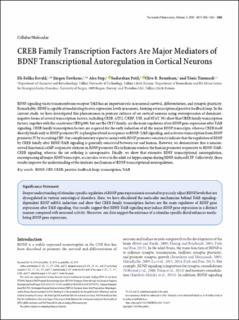| dc.description.abstract | BDNF signaling via its transmembrane receptor TrkB has an important role in neuronal survival, differentiation, and synaptic plasticity. Remarkably, BDNF is capable of modulating its own expression levels in neurons, forming a transcriptional positive feedback loop. In the current study, we have investigated this phenomenon in primary cultures of rat cortical neurons using overexpression of dominant-negative forms of several transcription factors, including CREB, ATF2, C/EBP, USF, and NFAT. We show that CREB family transcription factors, together with the coactivator CBP/p300, but not the CRTC family, are the main regulators of rat BDNF gene expression after TrkB signaling. CREB family transcription factors are required for the early induction of all the major BDNF transcripts, whereas CREB itself directly binds only to BDNF promoter IV, is phosphorylated in response to BDNF-TrkB signaling, and activates transcription from BDNF promoter IV by recruiting CBP. Our complementary reporter assays with BDNF promoter constructs indicate that the regulation of BDNF by CREB family after BDNF-TrkB signaling is generally conserved between rat and human. However, we demonstrate that a nonconserved functional cAMP-responsive element in BDNF promoter IXa in humans renders the human promoter responsive to BDNF-TrkB-CREB signaling, whereas the rat ortholog is unresponsive. Finally, we show that extensive BDNF transcriptional autoregulation, encompassing all major BDNF transcripts, occurs also in vivo in the adult rat hippocampus during BDNF-induced LTP. Collectively, these results improve the understanding of the intricate mechanism of BDNF transcriptional autoregulation. | en_US |

